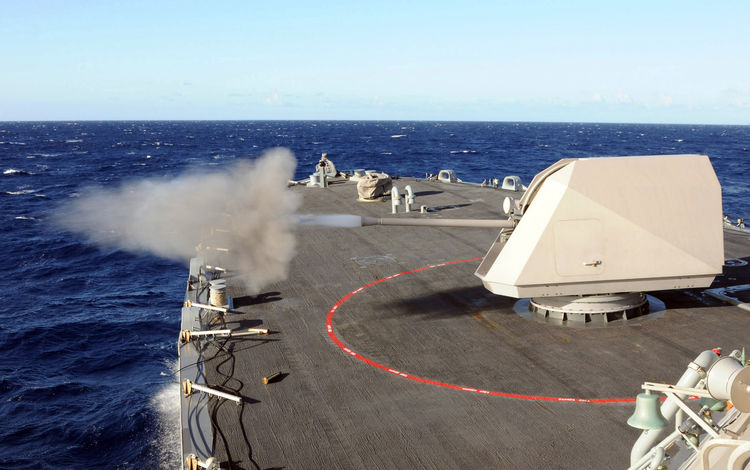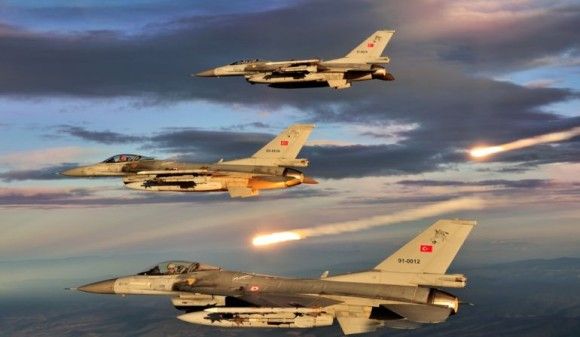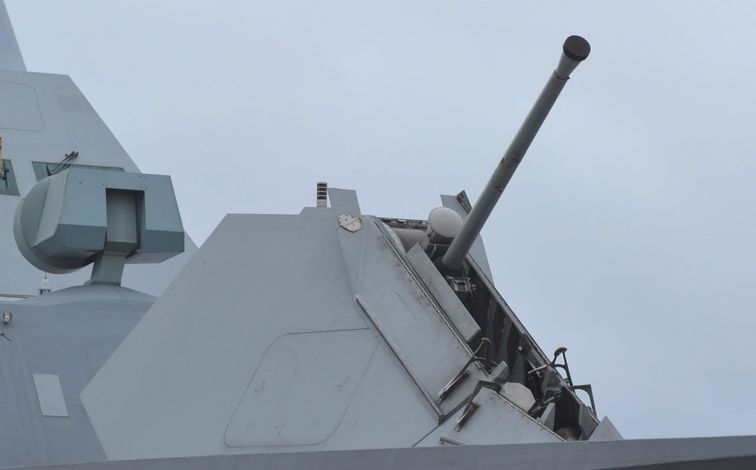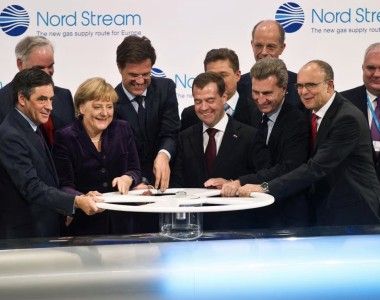BAE Systems Presents the 57 mm Gun Offer For the Polish Navy
During MSPO 2015 and DSEI 2015 BAE Systems presented the capabilities of its Bofors Mk3 57 mm Naval Gun. Defence24.pl has conducted an interview with Stefan Löfström, Head of Regional Sales - Europe at BAE Systems Bofors. The interview covers the aspects of BAE Systems Mk 3 naval guns offer for the Polish Miecznik coast defence vessels and Czapla patrol vessels.
Maksymilian Dura: What are the features of 57 mm guns when compared to 76 mm guns?
Stefan Löfström, Head of Regional Sales - Europe at BAE Systems Bofors: A 76 mm gun has only got an advantage when it is used for support the land forces activities. However, as I understand, the main role of the guns on the Polish vessels will be sea targets (vessels and asymmetric threats) and air targets (aircraft and anti-ship missiles). However, fighting targets on the ground will be of secondary importance.
When fighting surface and air targets (including approaching missiles), the capabilities of the 57 mm gun as the same compared to the 76 mm, if not better, with additional benefits related to the weight and size of the system and ammunition. The bigger capabilities are due to two reasons: they result from faster shooting (up to 220 rounds per minute), secondly, we have done much more to increase the result in the target (by increasing the amount of explosive in every shell, and constructing programmable ammunition in the right way).
Therefore, the amount of the explosive material that is sent on the target in a second is bigger for Mk3 57 than a 76 mm calibre. Therefore, we get more results in the target, at the same time increasing the precision of the fired rounds. Bofors is better in this area. In the first half a minute our gun is capable of sending more explosive material to the target than most other medium calibre artillery systems in the world.
What is the role of the artillery fire control radar in this respect?
In this respect the situation is the same for the 57 mm and 76 mm. Both solutions are dependent on the capabilities of the fire control system. The better the system, the greater the capabilities of the artillery set. In both cases neither Bofors nor Oto Melara are the suppliers of that equipment, and in both cases the success is up to the right integration of the fire control system with the gun. Therefore good integration is a key. We have managed to marry the Mk3 57 mm gun with many systems, developed by well-known companies such as: Saab, Thales, Terma or Navantia.

Is it only about the fire control radar?
No, because the Bofors Mk3 57 can equally well co-operate with an optoelectonical fire control system. Such combination have already been made (e.g. with Thales Mirador system) and work well also at night thanks to the use of thermal cameras. Anyway, the majority of radiolocation fire control systems have their own optoelectonic heads. To give an example, the Ceros 200 radar from Saab has been proven with the 57 mm gun on the Visby Swedish corvettes.
What is the Bofors Mk3 57 mm artillery system composed of?
Obviously, besides the gun, above it there is a radar measuring the speed of each round, allowing the calibration of the system, especially in the case of the 3P ammunition (setting the flight time, for instance). Each shell is programmed individually before firing. In this way the result on target is being increased.
A TV camera is an additional equipment. This is not an optoelectical fire control system, though. This is only a TV camera, which is the ultimate reserve. If the on-board fire control system goes down, then one can use it, but only for line-of-sight targeting. So it has a very limited capability, which could be useful in certain cases, e.g. when fighting asymmetrical threats.
You have mentioned 3P ammunition. Are there any new solutions in this area?
This is an already developed product, being offered with the gun. What was recently achieved is a quick change by the gun from fighting air targets to sea targets, with an automatic re-programming of the 3P ammunition. This possible immediately, without stopping the fire basically. The ammunition programming system, which works in the fraction of a second, allows this. This is a big advantage.
When it comes to new technologies, we are obviously looking for new solutions, but they haven’t been thoroughly checked yet, so cannot be offered to potential customers such as Poland. Yet, we stand ready to talk and co-operate with the Polish industry – also in the area of development of new programmable ammunition. We are open to proposals, but they have yet not come up on the Polish side. We continue to be open to talk about it.
What do you think about the so-called ‘telescoped ammunition’?
Obviously, we are conducting analytical work on the ‘telescoped ammunition’ but it is not on our priority list yet. We are monitoring what has been done in this area so far, but for the time being we do not plan to use the solution, especially for naval systems.
How could the numbers of ammunition to be taken on-board with the 57 mm and 76 mm guns, be compared?
The weight of the 57 mm ammunition is much less compared to the 76 mm ammunition. So, for instance, if we take 1000 rounds, which should somehow be stored on the ship, the system of storing this amount including the 57 mm gun weighs about 14 tons. As a comparison, the ammunition storage including the 76 mm gun weighs about 21 tons. This already has some influence on the stability of the vessel and the location of the centre of gravity, especially in the case of smaller ships.
Obviously, this depends on the construction of a vessel, but the majority of navies prefer the ammunition to be stored just below the gun. With a bigger calibre this becomes a serious problem, because it will have to be placed very deep into the platform (6 to 8 metres), due to the level of the on-board of the artillery system. This complicates the organization of the ammunition supply system.

What is also important is the amount of the ammunition, which is immediately available in the turret. In the case of the Mk3 57 mm, there are 120 rounds set in two feeders of the same-size on both sides of the gun, two handy parks set located on the sides of the turret, and two cassettes at the bottom of the gun.
Do you plan a new version of the 57 mm gun?
The 57 mm gun has been developed in stages and everyone can see the changes looking at the differences between the Mark 1 and Mark 2 systems, the Mark 2 and Mark 3 systems and looking at the solutions used on the Visby corvettes. We don’t have a detailed plan yet, not to mention a timescales to move to the Mark4/5 version.
The work on the modernization of the existing solutions is ongoing, though. Recently we completed the modernization of a complete computer system for the Mk3 gun (new generation computers have been used). But we also replace some components of the whole artillery system, when this increases the capabilities of the gun.








